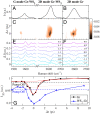Picosecond energy transfer in a transition metal dichalcogenide-graphene heterostructure revealed by transient Raman spectroscopy
- PMID: 35380900
- PMCID: PMC9169783
- DOI: 10.1073/pnas.2119726119
Picosecond energy transfer in a transition metal dichalcogenide-graphene heterostructure revealed by transient Raman spectroscopy
Abstract
Intense light–matter interactions and unique structural and electrical properties make van der Waals heterostructures composed by graphene (Gr) and monolayer transition metal dichalcogenides (TMD) promising building blocks for tunneling transistors and flexible electronics, as well as optoelectronic devices, including photodetectors, photovoltaics, and quantum light emitting devices (QLEDs), bright and narrow-line emitters using minimal amounts of active absorber material. The performance of such devices is critically ruled by interlayer interactions which are still poorly understood in many respects. Specifically, two classes of coupling mechanisms have been proposed, charge transfer (CT) and energy transfer (ET), but their relative efficiency and the underlying physics are open questions. Here, building on a time-resolved Raman scattering experiment, we determine the electronic temperature profile of Gr in response to TMD photoexcitation, tracking the picosecond dynamics of the G and 2D Raman bands. Compelling evidence for a dominant role of the ET process accomplished within a characteristic time of ∼4 ps is provided. Our results suggest the existence of an intermediate process between the observed picosecond ET and the generation of a net charge underlying the slower electric signals detected in optoelectronic applications.
Keywords: Raman scattering; energy transfer; graphene; ultrafast spectroscopy; van der Waals heterostructures.
Conflict of interest statement
The authors declare no competing interest.
Figures



References
-
- Georgiou T., et al. ., Vertical field-effect transistor based on graphene-WS2 heterostructures for flexible and transparent electronics. Nat. Nanotechnol. 8, 100–103 (2013). - PubMed
-
- Britnell L., et al. ., Strong light-matter interactions in heterostructures of atomically thin films. Science 340, 1311–1314 (2013). - PubMed
-
- Massicotte M., et al. ., Picosecond photoresponse in van der Waals heterostructures. Nat. Nanotechnol. 11, 42–46 (2016). - PubMed
LinkOut - more resources
Full Text Sources

